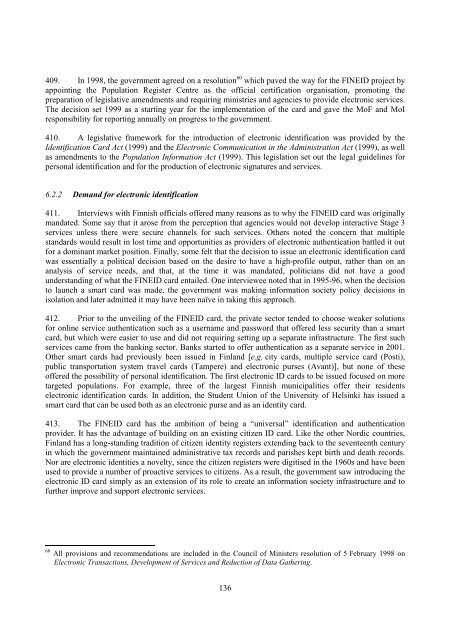e-GOVERNMENT IN FINLAND - ePractice.eu
e-GOVERNMENT IN FINLAND - ePractice.eu
e-GOVERNMENT IN FINLAND - ePractice.eu
You also want an ePaper? Increase the reach of your titles
YUMPU automatically turns print PDFs into web optimized ePapers that Google loves.
409. In 1998, the government agreed on a resolution 60 which paved the way for the F<strong>IN</strong>EID project by<br />
appointing the Population Register Centre as the official certification organisation, promoting the<br />
preparation of legislative amendments and requiring ministries and agencies to provide electronic services.<br />
The decision set 1999 as a starting year for the implementation of the card and gave the MoF and MoI<br />
responsibility for reporting annually on progress to the government.<br />
410. A legislative framework for the introduction of electronic identification was provided by the<br />
Identification Card Act (1999) and the Electronic Communication in the Administration Act (1999), as well<br />
as amendments to the Population Information Act (1999). This legislation set out the legal guidelines for<br />
personal identification and for the production of electronic signatures and services.<br />
6.2.2 Demand for electronic identification<br />
411. Interviews with Finnish officials offered many reasons as to why the F<strong>IN</strong>EID card was originally<br />
mandated. Some say that it arose from the perception that agencies would not develop interactive Stage 3<br />
services unless there were secure channels for such services. Others noted the concern that multiple<br />
standards would result in lost time and opportunities as providers of electronic authentication battled it out<br />
for a dominant market position. Finally, some felt that the decision to issue an electronic identification card<br />
was essentially a political decision based on the desire to have a high-profile output, rather than on an<br />
analysis of service needs, and that, at the time it was mandated, politicians did not have a good<br />
understanding of what the F<strong>IN</strong>EID card entailed. One interviewee noted that in 1995-96, when the decision<br />
to launch a smart card was made, the government was making information society policy decisions in<br />
isolation and later admitted it may have been naïve in taking this approach.<br />
412. Prior to the unveiling of the F<strong>IN</strong>EID card, the private sector tended to choose weaker solutions<br />
for online service authentication such as a username and password that offered less security than a smart<br />
card, but which were easier to use and did not requiring setting up a separate infrastructure. The first such<br />
services came from the banking sector. Banks started to offer authentication as a separate service in 2001.<br />
Other smart cards had previously been issued in Finland [e.g. city cards, multiple service card (Posti),<br />
public transportation system travel cards (Tampere) and electronic purses (Avant)], but none of these<br />
offered the possibility of personal identification. The first electronic ID cards to be issued focused on more<br />
targeted populations. For example, three of the largest Finnish municipalities offer their residents<br />
electronic identification cards. In addition, the Student Union of the University of Helsinki has issued a<br />
smart card that can be used both as an electronic purse and as an identity card.<br />
413. The F<strong>IN</strong>EID card has the ambition of being a “universal” identification and authentication<br />
provider. It has the advantage of building on an existing citizen ID card. Like the other Nordic countries,<br />
Finland has a long-standing tradition of citizen identity registers extending back to the seventeenth century<br />
in which the government maintained administrative tax records and parishes kept birth and death records.<br />
Nor are electronic identities a novelty, since the citizen registers were digitised in the 1960s and have been<br />
used to provide a number of proactive services to citizens. As a result, the government saw introducing the<br />
electronic ID card simply as an extension of its role to create an information society infrastructure and to<br />
further improve and support electronic services.<br />
60 All provisions and recommendations are included in the Council of Ministers resolution of 5 February 1998 on<br />
Electronic Transactions, Development of Services and Reduction of Data Gathering.<br />
136
















